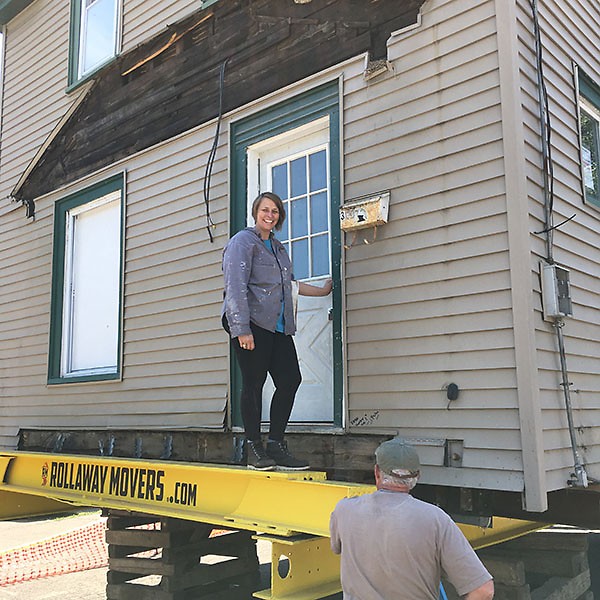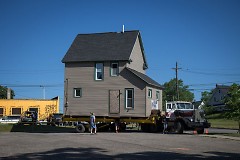For SiTE:LAB, a Grand Rapids-based arts non-profit, and Julie Schenkelberg, a Brooklyn- and Grand Rapids-based artist, “moving house” recently meant raising a house on Franklin Street SW off its foundation, rotating it and moving across the lot it to a new location on Rumsey Street SW in preparation for Schenkelberg’s project at SiTE:LAB for ArtPrize 2016.
One of ten vacant structures loaned to SiTE:LAB by Habitat for Humanity of Kent County, the house is slated for demolition in 2017 when Habitat begins a major neighborhood redevelopment project. With the house now in its new position on SiTE:LAB’s Rumsey Street Project site after the move in June, Schenkelberg intends to use the house as the basis for a freestanding sculpture by cutting, piercing and carving the structure over the next four months.
“When I saw the house with Paul (Amenta, SiTE:LAB co-founder and curator), I said, ‘I like this house. I like the smallness of it and I want to work with it, but it’s in the wrong spot.’ And that’s when Paul said, ‘Let’s just move it.’”
Over the past several years, Schenkelberg has created a series of large-scale installations in which she uses vintage domestic items, combined with industrial discarded materials to interpret the history of interior spaces. Schenkelberg views the use of an entire house as a natural extension of those projects. “Growing up in Cleveland, I was surrounded by a city transitioning into decay. I often thought of the potential of the structures to be art, to honor their history and to redeliver them into a different form.”
“I saw this house as its own person. I just wanted to get it to its own location. All of my work has been about the residual psychology and memory of places and I saw it as powerful with this house, compared to the other (nearby) houses.”
“The whole premise for the project is to take the house out of its context and put it in this new, open context so it can be seen from 360º. To see what its potential is and to open it up, to free it of the energy that’s inside, to make it something new. That’s always what I’m doing with materials.”
Schenkelberg’s vision for the house-based sculpture, named Transmigration, plays off drawing. “I like making sculpture because it reminds me of drawing. It’s like drawing in 3D with your body being the mark maker. (With the house) I have this vision of making marks that are just small enough that no one can fit through, maybe 6” wide or less, but then having them four feet long/tall, so you can see a lot of space, see into the house.”
Schenkelberg readily acknowledges the connection of this project to the work of Gordon Matta-Clark who created temporary pubic art projects out of entire structures in the 1970’s. “I see the house project as a female appropriation of Matta-Clark’s iconic cuts, translated into the language of my own process as an artist, paying homage to his important legacy. Working in a massive, invasive scale has traditionally been a male artist’s language, I am excited to transfer this scale into my own work.”
Transmigration represents Schenkelberg’s largest-scale work to date, work that involves the collective, collaborative effort of many.
Rollaway Movers, a Grand Rapids-based company that’s been moving houses for over 60 years handled the actual move. Schenkelberg and SiTE:LAB worked together coordinating details with the City of Grand Rapids and Habitat for Humanity to acquire the necessary permits prior to the move.
Documenting the house move in photos and video even became a group endeavor with SiTE:LAB, Stephen Mallon, and Sidecar Studios working together to cover all the angles. The GRCC Photography Program provided support and camera equipment for the documentation.
Schenkelberg will have two interns assisting her with the project, one from the University of Akron and one from the Rhode Island School of Design. Both undergraduate students will spend a few weeks each working with Schenkelberg to realize her vision for the house.
Her ArtPrize 2016 project will be Schenkelberg’s fourth piece exhibited with SiTE:LAB. Schenkelberg has twice participated in SiTE:LAB’s ArtPrize exhibitions, including her 2014 piece Symptomatic Constant, winner of the 2014 juried award for best installation. Schenkelberg also exhibited with SiTE:LAB at 2015’s Untitled exhibition at Art Basel Miami.
In addition to her exhibitions with SiTE:LAB, Schenkelberg’s recent 2015-2016 exhibitions include Color of Temperance: Embodied Energy at the Mattress Factory, and Swan Song at the Asya Geisberg Gallery in Chelsea, as well as a residency at the University of Akron.
The Rapidian, a program of the 501(c)3 nonprofit Community Media Center, relies on the community’s support to help cover the cost of training reporters and publishing content.
We need your help.
If each of our readers and content creators who values this community platform help support its creation and maintenance, The Rapidian can continue to educate and facilitate a conversation around issues for years to come.
Please support The Rapidian and make a contribution today.


